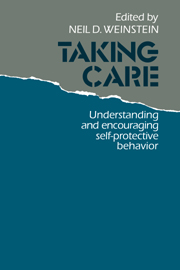Book contents
- Frontmatter
- Contents
- List of contributors
- Acknowledgments
- Introduction: studying self-protective behavior
- I Theoretical perspectives
- II Research and prevention programs for specific hazards
- 6 Why people take precautions against health risks
- 7 Community studies of smoking cessation
- 8 Preventing adolescent smoking
- 9 Natural hazards and precautionary behavior
- 10 Programs that encourage the adoption of precautions against natural hazards: review and evaluation
- 11 Why people take precautions against crime: a review of the literature on individual and collective responses to crime
- 12 Promoting citizen involvement in crime prevention and control
- 13 Injury prevention: limits to self-protective behavior
- 14 Perspectives on protective behaviors and work place hazards
- III Conclusion
- Index
14 - Perspectives on protective behaviors and work place hazards
Published online by Cambridge University Press: 03 February 2010
- Frontmatter
- Contents
- List of contributors
- Acknowledgments
- Introduction: studying self-protective behavior
- I Theoretical perspectives
- II Research and prevention programs for specific hazards
- 6 Why people take precautions against health risks
- 7 Community studies of smoking cessation
- 8 Preventing adolescent smoking
- 9 Natural hazards and precautionary behavior
- 10 Programs that encourage the adoption of precautions against natural hazards: review and evaluation
- 11 Why people take precautions against crime: a review of the literature on individual and collective responses to crime
- 12 Promoting citizen involvement in crime prevention and control
- 13 Injury prevention: limits to self-protective behavior
- 14 Perspectives on protective behaviors and work place hazards
- III Conclusion
- Index
Summary
Introduction
Need for hazard control at work
Occupational disease and injury are preventable. Historically, efforts to improve work place conditions have been directed toward identifying and evaluating significant dangers in the expectation that, with knowledge of the hazards, someone would do something to reduce their impact. New regulatory legislation and other factors in the past decade have shifted this passive approach to hazard reduction to a more active one that emphasizes the development and application of relevant control technologies (Occupational Safety & Health Act, 1970; Department of Health & Human Services, 1980; Burton, Coleman, Coltharp, Hoover, & Vandervort, 1980; Sheehy, 1983). Although there were indications of a declining rate of occupational injuries and illness in the period from 1980 to 1983 (Office of Technology Assessment, 1985), later data for 1984 show an upturn (Occupational Health and Safety Letter, 1985). The composite figures taken from several reporting systems reveal the enormity of the problem. For example, the National Institute for Occupational Safety and Health (NIOSH), in collating the latest data from hospital emergency room cases, state workmen's compensation claims, Bureau of Labor Statistics reports, and National Safety Council surveys, estimates that at least 10 million people suffer traumatic injuries on the job each year (Morbidity & Mortality Weekly Reports, 1984). About 3 million of these injuries are severe, 70,000 resulting in some form of permanent impairment, and 10,000 are fatal.
- Type
- Chapter
- Information
- Taking CareUnderstanding and Encouraging Self-Protective Behavior, pp. 298 - 322Publisher: Cambridge University PressPrint publication year: 1987
- 1
- Cited by



